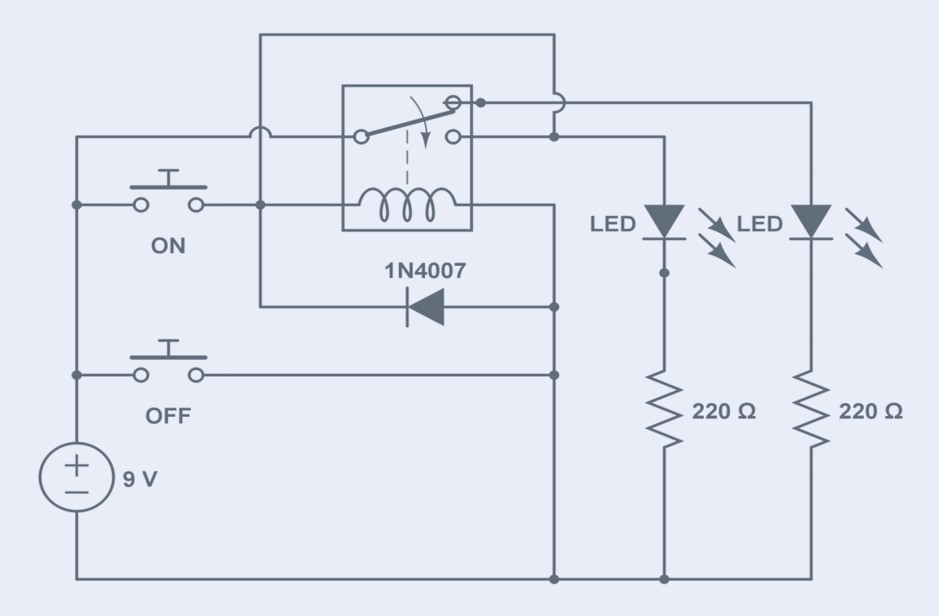Time: 2024-01-30 17:05:04View:
A latching relay, also known as a bistable relay, is a type of electrical relay that maintains its state even after the control signal is removed. Unlike traditional relays that rely on a continuous power supply to keep the contacts closed or open, a latching relay utilizes a permanent magnet or mechanical latch mechanism to hold the contacts in place. This unique design allows latching relays to conserve energy and reduce power consumption, making them suitable for applications where power efficiency is crucial. It can hold its contact position indefinitely even without power supplied to the coil. This type of relay is operated by two momentary-acting switches or sensors, one for "setting" the relay and the other for "resetting" it. Once the actuating switch is released, the latching relay retains its position, thus serving as a fundamental memory function.
The operation of a latching relay involves two stable states: set and reset. When the control signal is applied, the relay transitions from its current state to the opposite state. For example, if the relay is initially in the reset state, applying a control signal will move it to the set state, and vice versa. Once the relay reaches a particular state, it remains in that state until the control signal is applied again to switch it to the other state.
Latching relays are commonly used in applications where power interruption is a concern. Since they don't require a continuous power supply to maintain their state, they are ideal for situations where power outages or fluctuations are common. For instance, they can be found in energy management systems, uninterruptible power supplies (UPS), or control systems for critical machinery.
One of the significant advantages of latching relays is their ability to hold their state even in the absence of power. This characteristic makes them suitable for applications where power consumption must be minimized. In addition to energy efficiency, latching relays offer a long service life due to their mechanical design, resulting in reduced maintenance requirements and increased reliability.
Latching relays find applications in various industries, including industrial automation, telecommunications, transportation, and home automation. In industrial settings, they can be used for controlling motorized valves, conveyor belts, or lighting systems. In telecommunications, latching relays are utilized for signal routing and switching applications. They can also be integrated into circuit breakers to provide fault isolation and protection in power distribution systems.
In summary, latching relays are specialized electrical relays that retain their state without the need for a continuous power supply. Their unique design allows for energy efficiency, reduced power consumption, and reliable operation. With applications in various industries, latching relays provide an effective solution for controlling electrical systems and devices while minimizing power interruption and optimizing energy management.

Latching relays operate through a unique mechanism that allows them to maintain their state even after the control signal is removed. The working principle of a latching relay involves the use of a permanent magnet or a mechanical latch mechanism.
Latching relays typically consist of two coils, often referred to as the set coil and reset coil. These coils are responsible for switching the relay between the set and reset states. When a control signal is applied to the set coil, it creates a magnetic field that attracts the relay's armature and closes the contacts. Once the contacts are closed, the set coil is de-energized, and the magnetic field generated by the permanent magnet or mechanical latch mechanism takes over to hold the contacts in place.
To switch the relay to the reset state, a control signal is applied to the reset coil. This signal generates a magnetic field that opposes the field created by the permanent magnet or mechanical latch. As a result, the armature is pulled away from the contacts, opening them. Once the contacts are open, the reset coil is de-energized, and the magnetic field from the permanent magnet or latch mechanism maintains the open state.
The key feature of a latching relay is that it doesn't rely on a continuous power supply to keep the contacts closed or open. Instead, it uses the magnetic field generated by the permanent magnet or mechanical latch to hold the contacts in position. This characteristic enables latching relays to conserve energy and reduce power consumption, making them highly efficient in various applications.
To transition between the set and reset states, a latching relay requires an external control signal. This signal can be provided by a push button, a switch, or an electronic circuit, depending on the specific application. When the control signal is applied, the relay's internal mechanism moves the armature to the desired state, and the contacts change their position accordingly. Once in the desired state, the latching relay maintains that position until the control signal is applied again to switch it to the opposite state.
The operation of latching relays offers several advantages. Since they don't require a continuous power supply, they are suitable for applications where power interruptions are common or where power consumption needs to be minimized. Additionally, their mechanical design provides long service life and increased reliability, making them ideal for critical systems.
In summary, latching relays work by utilizing a permanent magnet or mechanical latch mechanism to hold the contacts in place, maintaining their state even after the control signal is removed. The relay's set and reset coils are used to transition between the two states, with the magnetic field generated by the permanent magnet or latch mechanism maintaining the position of the contacts. This unique operation enables latching relays to be energy efficient, reliable, and suitable for various applications where power interruption and power consumption need to be minimized.
Relays and latching relays are both types of electrical switches, but they differ in their operating principles and functionality. Here are the key differences between relays and latching relays.
1. Operating Principle: Relays operate based on the principle of an electromagnet. When a control signal is applied to the relay coil, it creates a magnetic field that attracts the armature, causing the contacts to close or open. The relay requires a continuous power supply to maintain the contacts in the desired position. In contrast, latching relays utilize a permanent magnet or mechanical latch mechanism to hold the contacts in place without the need for continuous power.
2. Power Consumption: Relays consume power as long as the coil is energized, even when the contacts are in a static state. This continuous power consumption can be significant in some applications. On the other hand, latching relays are designed to minimize power consumption. Once the contacts are set or reset, they remain in that position until the control signal is applied again, allowing latching relays to conserve energy and reduce power usage.
3. Energy Efficiency: Due to their design, latching relays are generally more energy-efficient than traditional relays. The absence of continuous power consumption in latching relays reduces energy waste and makes them suitable for applications that prioritize power efficiency, such as battery-operated systems or environments where power outages are common.
4. Holding State: Relays rely on the continuous flow of current through the coil to maintain their contacts in a specific position. If the power supply is interrupted, the relay can revert to its default state. In contrast, latching relays have the ability to hold their state even in the absence of power. This feature makes latching relays more suitable for applications where power interruption or fluctuation is a concern, as they can maintain their position without relying on an external power source.
5. Control Signal: Relays require a continuous control signal to keep the contacts closed or open. Once the control signal is removed, the relay returns to its default state. Latching relays, on the other hand, use a control signal to switch between the set and reset states, but once the desired state is reached, the control signal can be removed without affecting the relay's position. The latching relay will maintain its state until the control signal is applied again to switch it to the opposite state.
6. Applications: Relays are commonly used in various applications where switching high power loads or controlling circuits is required. They are widely used in industrial automation, power distribution systems, automotive electronics, and more. Latching relays are often employed in situations where power efficiency, energy management, and reliable operation with minimal power interruption are crucial. They find applications in energy management systems, telecommunications, transportation, home automation, and other fields.
In summary, relays and latching relays differ in their operating principles, power consumption, energy efficiency, ability to hold their state without power, control signal requirements, and applications. Relays rely on continuous power supply and control signals to maintain their contacts, while latching relays use a mechanical latch or permanent magnet to hold their contacts in place, requiring less power and offering energy efficiency and power interruption resilience.

Latching relays are an excellent choice for light control applications, offering energy-efficient and reliable operation. Their unique characteristics make them well-suited for scenarios where power efficiency and precise control are essential.
In light control applications, latching relays can effectively switch lights on and off based on user input or environmental conditions. For instance, in a home automation system, latching relays can be seamlessly integrated with sensors or switches to control lighting in different rooms. When a control signal is applied to the set coil of the latching relay, it transitions to the set state, closing the contacts and turning on the lights. Once the lights are illuminated, the relay maintains this state even after removing the control signal, thanks to the incorporated permanent magnet or mechanical latch mechanism. This feature ensures energy efficiency as the relay doesn't consume continuous power to sustain the lights.
To turn off the lights, a control signal is applied to the reset coil of the latching relay. This signal causes the relay to transition to the reset state, opening the contacts and switching off the lights. The relay remains in this state until the control signal is applied again to switch it back to the set state. This control mechanism allows for precise and reliable light control without the need for a constant power supply, resulting in reduced energy consumption and improved overall energy efficiency.
Moreover, latching relays can be seamlessly integrated with timers or automation systems to enable scheduled or automated light control. In outdoor lighting applications, for instance, latching relays can be programmed to turn on and off at specific times or based on daylight conditions. This capability proves highly beneficial for energy-saving measures, security purposes, or creating desired lighting atmospheres.
The ability of latching relays to hold their state even in the absence of power ensures uninterrupted light control. In areas prone to power outages or fluctuations, such as remote locations or regions with unreliable power supply, latching relays provide a reliable solution. They effectively maintain the state of the lights even during power interruptions, ensuring consistent lighting conditions and minimizing inconvenience.
Furthermore, latching relays boast a long service life and high reliability due to their mechanical design. This makes them well-suited for demanding environments and reduces the need for frequent maintenance, ultimately making them a cost-effective choice for light control applications.
In summary, latching relays offer an energy-efficient and reliable solution for light control applications. Their ability to maintain their state without continuous power consumption ensures energy efficiency, while their mechanical design guarantees longevity and reliability. Whether implemented in residential or commercial settings, latching relays provide precise and customizable control over lighting systems, facilitating efficient energy management and delivering reliable light control even in challenging conditions.
